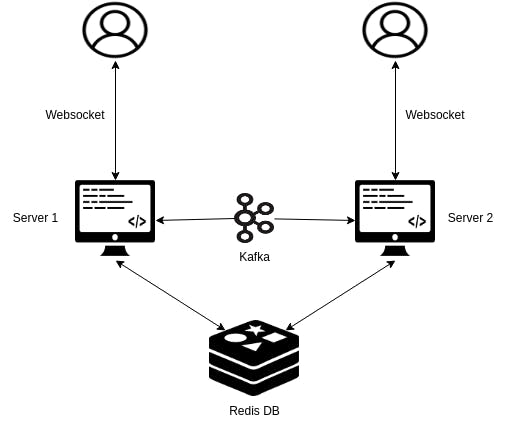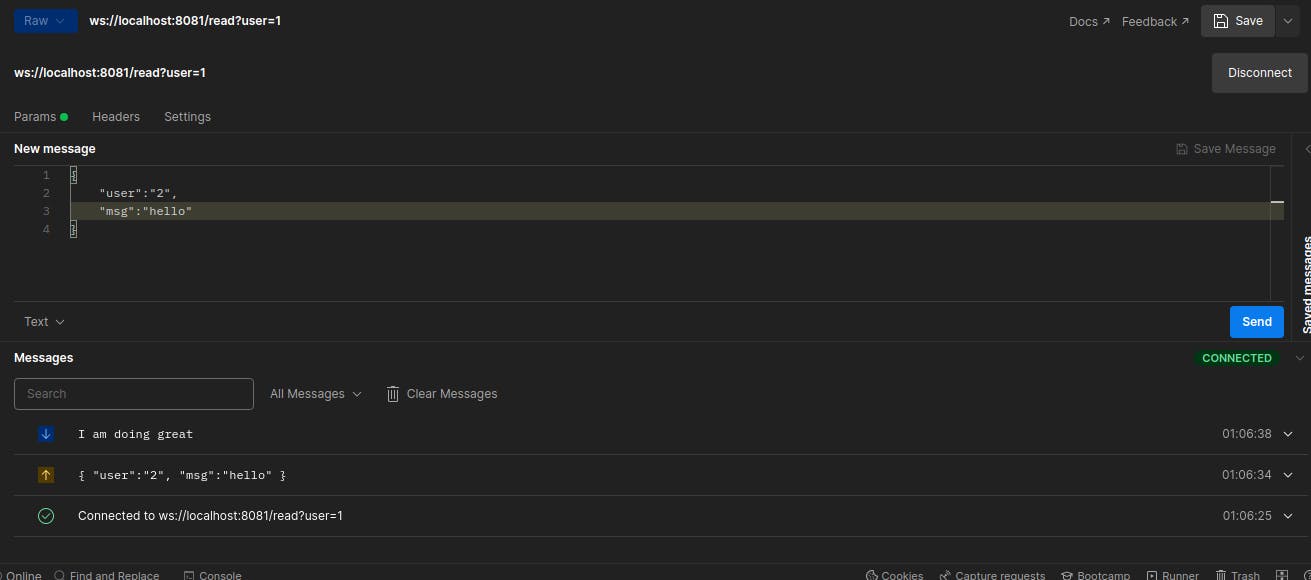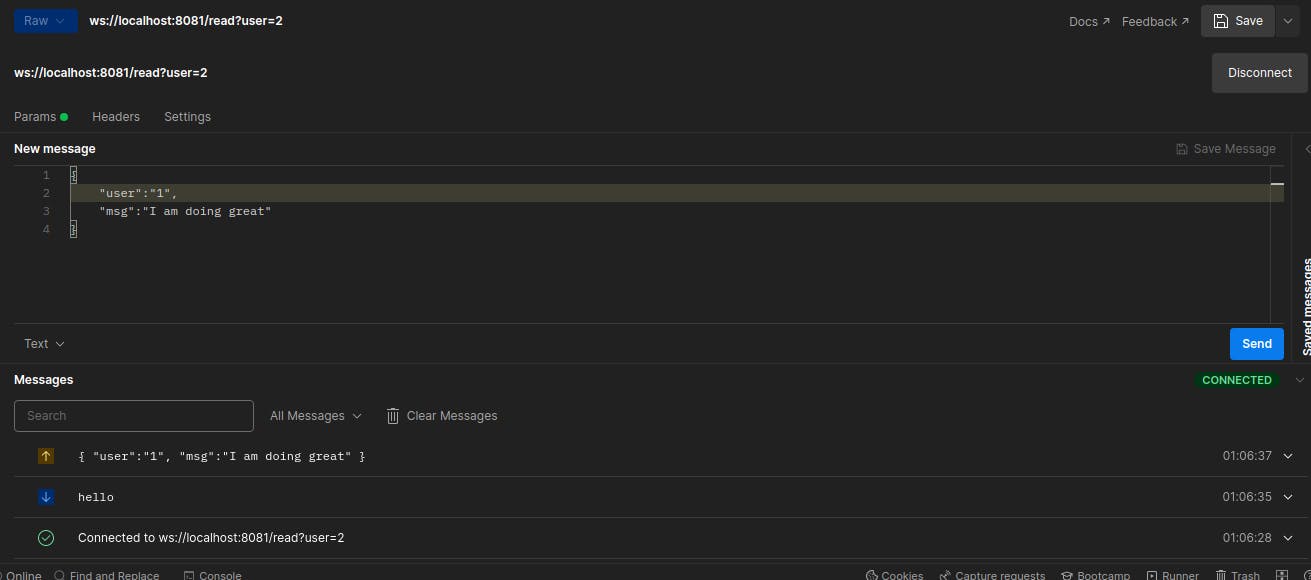Introduction
Real-time chat is virtually any online communication that provides a real-time or live transmission of text messages from sender to receiver. A variety of software programs are available to enable real-time chat between individuals using Internet services. Chat messages are often brief to let other participants respond swiftly, thereby creating a feeling much like a spoken conversation. This mode of communication differentiates real-time chats from other forms of text-based online communications, including emails and Internet forums. Real-time chat uses Web-based apps, which permit communication that is usually addressed directly but is anonymous among users in a multi-user environment.
WebSockets are a great fit for applications like chats or simple games. Chat sessions are usually long-lived, with the client receiving messages from other participants over a long period. Chat sessions are also bidirectional – clients want to send chat messages, and see chat messages from others. Unlike regular HTTP requests, WebSocket connections can be kept open for a long time and have an easy interface for exchanging data between the client and server in the form of frames. WebSockets are also a widely supported technology. All modern browsers can work with WebSockets out of the box, and frameworks to work with WebSockets exist in many programming languages and on many platforms.
Prerequisite
Before we move on to implementation there are basic terms and technologies we need to be familiar with.
Kafka:
To handle a large number of connections, we will be needing multiple instances of a server, thus there will be a need for a medium for server-to-server communication. In a very fast, reliable, persisted, fault-tolerance and zero downtime manner, Kafka offers a Pub-sub and queue-based messaging system. The producers send the message to a topic and the consumer can select any one of the message systems according to their wish.
Redis:
For keeping account of online users and managing messages between multiple servers we would be needing a fast and reliable database system. Redis delivers sub-millisecond response times, enabling millions of requests per second for real-time applications in industries like gaming, ad tech, financial services, healthcare, and IoT. Today, Redis is one of the most popular open-source engines, named the "Most Loved" database by Stack Overflow for five consecutive years. Because of its fast performance, Redis is a popular choice for caching, session management, gaming, leaderboards, real-time analytics, geospatial, ride-hailing, chat/messaging, media streaming, and pub/sub applications.
Building a Chatting Application
Now, Since we have gotten familiar with the technologies we will be using, below is the design diagram for our application:

For our application, we will build a messaging server in Golang
Docker-compose setup
Below is the docker-compose file we will be using to set up our services:
version: '2'
services:
zookeeper:
image: confluentinc/cp-zookeeper:latest
environment:
ZOOKEEPER_CLIENT_PORT: 2181
ZOOKEEPER_TICK_TIME: 2000
ports:
- 22181:2181
kafka:
image: confluentinc/cp-kafka:latest
depends_on:
- zookeeper
ports:
- 9093:9093
environment:
KAFKA_BROKER_ID: 1
KAFKA_ZOOKEEPER_CONNECT: zookeeper:2181
KAFKA_ADVERTISED_LISTENERS: PLAINTEXT://kafka:9092,PLAINTEXT_HOST://localhost:9093
KAFKA_LISTENER_SECURITY_PROTOCOL_MAP: PLAINTEXT:PLAINTEXT,PLAINTEXT_HOST:PLAINTEXT
KAFKA_INTER_BROKER_LISTENER_NAME: PLAINTEXT
KAFKA_OFFSETS_TOPIC_REPLICATION_FACTOR: 1
KAFKA_CREATE_TOPICS: my-kafka-topic
redis:
image: 'bitnami/redis:latest'
ports:
- "6379:6379"
environment:
- ALLOW_EMPTY_PASSWORD=yes
In the above docker-compose.yml file images used:
For Redis:
bitnami/redis:latestFor Kafka:
confluentinc/cp-kafka:latest
Now that we have set up our docker-compose file we need to establish our services with our server using golang
For this we would be using the golang library:
For Redis:
github.com/gomodule/redigo/redisFor Kafka:
github.com/segmentio/kafka-goFor Websockets:
github.com/gorilla/websocket
To create a server let's create a server object to access the services
type Server struct {
userCons map[string]*websocket.Conn
ctx context.Context
reader *kafka.Reader
writer *kafka.Writer
mut sync.Mutex
RedisClient *redis.Client
}
To initialize these services below is the InitService() function:
func InitService() *Server {
return &Server{
userCons: make(map[string]*websocket.Conn),
ctx: context.Background(),
reader: kafka.NewReader(kafka.ReaderConfig{
Brokers: []string{"localhost:9093"},
Topic: "my-kafka-topic",
}),
writer: &kafka.Writer{
Addr: kafka.TCP("localhost:9093"),
Topic: "my-kafka-topic",
Balancer: &kafka.Murmur2Balancer{},
},
mut: sync.Mutex{},
RedisClient: redis.NewClient(&redis.Options{
Addr: "localhost:6379",
Password: "",
DB: 0,
}),
}
}
Now that we have initialized our services, we need to create a structure to encode-decode messages. Below is the structure we will be using:
type UserMessage struct {
User string `json:"user"`
Message string `json:"msg"`
}
The user in the structure will have the recipient user ID and the Message we need to send.
Now, we can start creating our handler to receive and send messages. Let's start with initialising a handshake using Upgrade() method
// Upgrade your connection to websocket connection
conn, err := upgrades.Upgrade(w, r, nil)
if err != nil {
w.WriteHeader(http.StatusInternalServerError)
return
}
Once the handshake is done we need to check for the sender's user ID from the parameters and mark him online. To do that we will be using Redis and userCons map to store connection objects and tag users online
// Get Sender user ID from parameter
inID := r.URL.Query().Get("user")
// Writing connection in user connection map and into the redis to keep account if user is online into which server
srv.mut.Lock()
srv.userCons[inID] = conn
srv.RedisClient.Set(inID, "true", 0)
srv.mut.Unlock()
Once we mark the user online we will be sending the user un-received messages which he may get when he was offline. We are storing un-received messages in our Redis Database.
// Sending un-recieved messages which was sent when user was offline
// Retrieving messages from Redis server
val, err := srv.RedisClient.Get(inID + "msg").Result()
if err == nil && val != "" {
// Function to send old messaged to the user
go srv.SendOldMsg(inID, val)
}
func (srv *Server) SendOldMsg(key string, uMsgs string) {
fmt.Println("Sending old messages")
// splitting old messages
messages := strings.Split(uMsgs, "|")
srv.mut.Lock()
for _, msg := range messages {
// sending un-received message to the user via websocket
if err := srv.userCons[key].WriteMessage(1, []byte(msg)); err != nil {
return
}
}
srv.RedisClient.Set(key, "", 0)
srv.mut.Unlock()
}
Now once the user received his messages we can start with a chat session we will be using two go func() for that one will receive messages from WebSocket and broadcast them into kafka and the other will receive messages from Kafka and send them to the recipient via WebSocket. In case the recipient is offline, the messages sent by the user will be stored in Redis.
// Receiver Server
go func() {
for {
// Get messages from kafka which was broadcast by the server to which sender was connected to
msg, err := srv.reader.ReadMessage(srv.ctx)
if err != nil {
break
}
fmt.Println("Kafka Message received: ", string(msg.Value))
var usrMsg UserMessage
err = json.Unmarshal(msg.Value, &usrMsg)
if err != nil {
break
}
fmt.Println("Received:", usrMsg)
// Retrieve connection object from map and send received messages to user via websocket
srv.mut.Lock()
// Checking if recipient is connected to the server
if conn, ok := srv.userCons[usrMsg.User]; ok {
// if recipient is connected sending messages via websocket
if err := conn.WriteMessage(1, []byte(usrMsg.Message)); err != nil {
break
}
}
srv.mut.Unlock()
}
}()
The above code receives a message from Kafka and checks if the recipient is connected to the server. If there exists a connection, the server sends the message to the recipient via WebSocket.
// Sender Server
for {
// Getting messages from websoket
_, body, err := conn.ReadMessage()
if err != nil {
break
}
// structure containing recipient user ID and messages
var usrMsg UserMessage
err = json.Unmarshal(body, &usrMsg)
if err != nil {
break
}
// checking if recipient is connected to any of the server instances via Redis
val, err = srv.RedisClient.Get(usrMsg.User).Result()
if err != nil || val == "false" {
// if recipient is not connected, saving messages to redis, so that recipient can receive them when he comes online
val, err := srv.RedisClient.Get(usrMsg.User + "msg").Result()
if err != nil {
val = usrMsg.Message
} else {
// if there are already old messages, appending new messages to them
val = val + "|" + usrMsg.Message
}
// writing un-recieved messages to redis for recipient to read when he comes online
srv.mut.Lock()
srv.RedisClient.Set(usrMsg.User+"msg", val, 0)
srv.mut.Unlock()
log.Printf("Succes: Msg written in redis for user: %v and msg: %v", usrMsg.User, usrMsg.Message)
} else {
// In case recipient is online broadcasting message via kafka so that receiver server can get the message
tmp := string(body)
msg := kafka.Message{
Key: []byte(usrMsg.User),
Value: []byte(tmp),
}
// writing message to kafka
err = srv.writer.WriteMessages(srv.ctx, msg)
if err != nil {
log.Printf("Error: %v", err)
}
log.Printf("Succes: Msg written in kafka for user: %v and msg: %v", usrMsg.User, string(msg.Value))
}
}
The above code receives json encoded messages from WebSocket and decode it into the structure. If the recipient is online, the server will broadcast the message into Kafkaso that the server instance to which the recipient is connected will receive the message. In case the recipient is offline, the messages will be stored in Redis.
// return to handler in case user disconnect from server
// setting map and redis, so that user appears offline
srv.mut.Lock()
delete(srv.userCons, inID)
srv.RedisClient.Set(inID, "false", 0)
srv.mut.Unlock()
fmt.Println("User Deleted Redis")
Once the connection is disconnected, we will remove the connection object from the map and mark the user as offline in Redis.
It is worth noting that in the above code there are two channels for Redis one stores the user's un-received messages and the other store's user's online status.
The code demonstrates how a multi-instance server chatting service will work and how messages will manage in such a complex system.
Below is the main() func we used for the server:
func main() {
srv := InitService()
fmt.Println("Starting Server...")
router := chi.NewRouter()
router.Route("/", func(ws chi.Router) {
ws.Get("/", srv.Alive)
ws.Get("/read", srv.ReadMsg)
})
log.Fatal(http.ListenAndServe(":8081", router))
}
We can test this server by sending a WebSocket request via the postman. Below are the output snippets of postman:


Conclusion:
In this blog, we explored real-time chatting services, their system design and how the messages are handled. Also, we have implemented a multi-server instance chatting service which is managed but services like Redis and Kafka which can transmit messages reliably between users with very low latency.
Below is the Github link for the above implementation:
https://github.com/golang-llc/Blogs/tree/main/WebsocketBasedChattingApplication

